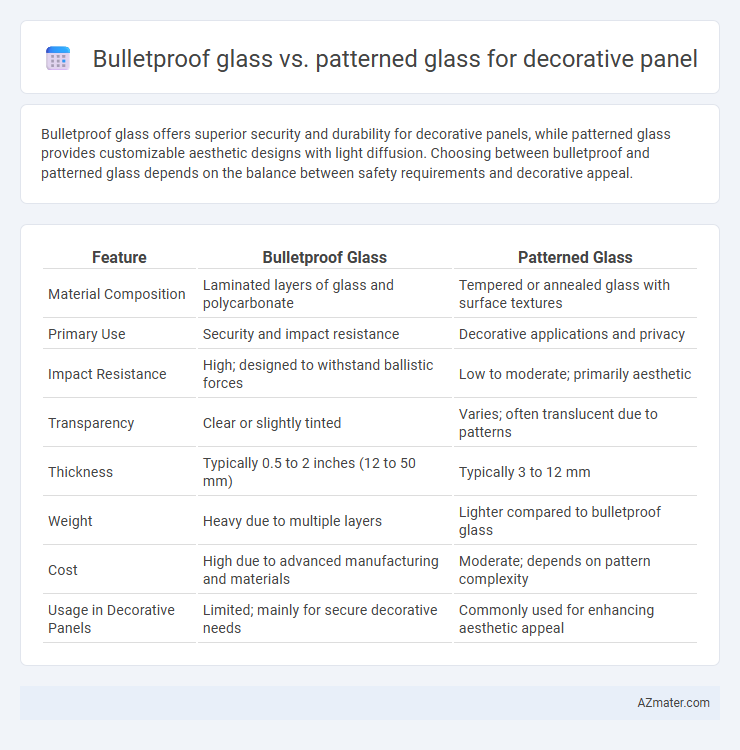Bulletproof glass offers superior security and durability for decorative panels, while patterned glass provides customizable aesthetic designs with light diffusion. Choosing between bulletproof and patterned glass depends on the balance between safety requirements and decorative appeal.
Table of Comparison
| Feature | Bulletproof Glass | Patterned Glass |
|---|---|---|
| Material Composition | Laminated layers of glass and polycarbonate | Tempered or annealed glass with surface textures |
| Primary Use | Security and impact resistance | Decorative applications and privacy |
| Impact Resistance | High; designed to withstand ballistic forces | Low to moderate; primarily aesthetic |
| Transparency | Clear or slightly tinted | Varies; often translucent due to patterns |
| Thickness | Typically 0.5 to 2 inches (12 to 50 mm) | Typically 3 to 12 mm |
| Weight | Heavy due to multiple layers | Lighter compared to bulletproof glass |
| Cost | High due to advanced manufacturing and materials | Moderate; depends on pattern complexity |
| Usage in Decorative Panels | Limited; mainly for secure decorative needs | Commonly used for enhancing aesthetic appeal |
Introduction: Bulletproof Glass vs Patterned Glass for Decorative Panels
Bulletproof glass offers exceptional strength and security for decorative panels, making it ideal for high-risk environments requiring impact resistance. Patterned glass provides versatile aesthetic appeal with customizable textures and designs, enhancing interior decor without compromising light transmission. Choosing between bulletproof and patterned glass depends on the balance between safety requirements and design preferences.
Material Composition and Manufacturing Processes
Bulletproof glass for decorative panels typically consists of multiple layers of laminated glass and polycarbonate or acrylic interlayers designed to absorb and dissipate impact energy, ensuring high durability and security. Patterned glass is produced by rolling molten glass through textured rollers, embedding intricate patterns on the surface without sacrificing transparency, making it ideal for aesthetic appeal and privacy. The manufacturing of bulletproof glass involves precision lamination and curing processes, whereas patterned glass is created through controlled mechanical embossing and tempering techniques.
Aesthetic Appeal: Pattern Options and Design Flexibility
Patterned glass offers extensive design flexibility with a variety of textures, patterns, and translucency levels, allowing for creative and customized decorative panels that enhance aesthetic appeal. Bulletproof glass, while clear and sturdy, primarily focuses on security rather than decorative variety, limiting its pattern options and design adaptability. Choosing patterned glass for decorative panels provides more opportunities to achieve unique visual effects and tailor-made styles without compromising on the artistic aspect.
Strength and Durability Comparison
Bulletproof glass offers superior strength and impact resistance compared to patterned glass, making it ideal for security-focused decorative panels. Patterned glass provides aesthetic appeal with moderate durability but is more prone to cracking under heavy impact. For applications requiring robust protection and long-lasting performance, bulletproof glass significantly outperforms patterned glass in structural integrity and resilience.
Security Features: Protection Levels
Bulletproof glass offers superior protection levels with multilayered construction designed to resist high-impact forces and ballistic threats, making it ideal for high-security environments. Patterned glass provides moderate protection by obscuring visibility and offering some resistance to shattering but lacks the robust impact resistance found in bulletproof variants. Security applications prioritize bulletproof glass for its certified ballistic ratings, while patterned glass is preferred for decorative privacy without compromising moderate safety.
Light Transmission and Privacy Considerations
Bulletproof glass offers high light transmission, typically around 80-90%, ensuring clear visibility while providing superior security, but it compromises privacy due to its transparency. Patterned glass features varied textures and designs that diffuse light, reducing glare and enhancing privacy by obscuring direct views without significantly diminishing natural light levels. When selecting decorative panels, balancing light transmission and privacy depends on the application's security needs and desired aesthetic effects, with patterned glass favored for privacy-focused spaces and bulletproof glass for security-critical environments.
Cost Analysis: Initial Investment and Maintenance
Bulletproof glass for decorative panels requires a significantly higher initial investment due to its multi-layered construction and specialized materials, often costing three to five times more than patterned glass. Maintenance expenses for bulletproof glass remain relatively low because of its durable, impact-resistant nature, whereas patterned glass may demand more frequent repairs or replacements due to its susceptibility to scratches and chips. Over the long term, bulletproof glass offers better value in high-traffic or security-sensitive environments despite the higher upfront cost.
Installation Challenges and Compatibility
Bulletproof glass, known for its multi-layered construction of polycarbonate and tempered glass, presents installation challenges due to its substantial weight and the need for reinforced framing systems, which may increase overall costs and labor time. Patterned glass offers greater ease of installation with standard framing due to its lighter weight and uniform thickness, but compatibility issues can arise when used in environments requiring impact resistance or high-security features. Ensuring proper compatibility depends on balancing aesthetic preferences with structural requirements, where bulletproof glass excels in safety, and patterned glass enhances decorative appeal with straightforward installation.
Environmental Impact and Sustainability
Bulletproof glass features high durability and typically requires energy-intensive manufacturing, contributing to a larger carbon footprint compared to patterned glass. Patterned glass often uses simpler production methods and can incorporate recycled materials, enhancing its sustainability profile for decorative panels. Choosing patterned glass reduces environmental impact by promoting energy efficiency and material recycling in architectural applications.
Best Applications: Choosing the Right Glass for Decorative Panels
Bulletproof glass is ideal for decorative panels in high-security environments such as banks, government buildings, and luxury retail stores where safety and impact resistance are paramount. Patterned glass, with its textured designs and ability to diffuse light, excels in residential and commercial interiors like office partitions, shower panels, and cabinet doors, offering both privacy and aesthetic appeal. Selecting glass depends on prioritizing protection with bulletproof glass or enhancing visual interest and privacy with patterned glass to suit the panel's functional and decorative requirements.

Infographic: Bulletproof glass vs Patterned glass for Decorative panel
 azmater.com
azmater.com